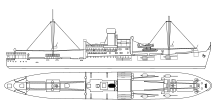Auxiliary cruiser

Auxiliary cruisers were converted, armed merchant ships or passenger steamers for the trade war .
General
The purpose of the auxiliary cruiser concept was to make other warships available to a country's fleet quickly and without a large amount of material by converting merchant ships. This conversion mostly only consisted of the installation of several guns and the associated fire control system . Major changes, such as the installation of armor or the redesign of the internal structure of a merchant ship with large cargo holds to become a warship with small rooms to limit damage, were practically not carried out because they would have been too time-consuming and ultimately would have been of little use in an emergency. In any case, auxiliary cruisers were always far inferior to a real warship in terms of combat power and, with a few exceptions, also in speed.
The area of application also resulted from the limitations of the auxiliary cruiser. It was mostly used for tasks where the risk of contact with enemy naval forces was relatively low, the task did not require a full-fledged warship or there were not enough ships available. The exact type of operation depended on the tasks and the strategy of the naval forces in the respective country.
history
Auxiliary cruisers already existed in the days of sailing ships . They were used in the Spanish-American War of 1898 and the Japanese-Russian War from 1904 to 1905 , among others .
During the world wars
Numerous auxiliary cruisers were used by the warring powers during the First World War . In the Navy of Austria-Hungary raiders were as Auxiliarkreuzer referred.
In the two world wars, Great Britain used its auxiliary cruisers to carry out the sea blockade against Germany by having them patrol the entrances to the North Sea and control all merchant ships passing there. Many ships were required for this task, but at the same time no real warships, as merchant ships did not pose a major threat and the patrol area was far from the bases of the German fleet. Otherwise, this task would have tied up numerous Royal Navy cruisers and severely weakened them. Another task was the escort of convoys, in order to give them a minimum of security, since not enough warships were available for the numerous convoys and these therefore only the most important convoys, such as. B. troop transports were assigned.
In contrast to the British, the German auxiliary cruisers were used as trade disruptors. They were supposed to pass through the British blockade undetected and then attack British merchant ships far away from the war zone so that the Royal Navy had to withdraw ships from the war zone and use them to protect their convoys.
The selection of the ships that were converted into auxiliary cruisers also depended on the intended task of the auxiliary cruiser. Large passenger ships were mostly converted for escort and patrol tasks , as these had a relatively high speed and could overtake most of the other merchant ships. However, since these ships consumed large amounts of coal , they were unsuitable for use as trade disturbers who were supposed to operate far away from their own bases for a long time. For this task, slower cargo ships were chosen that had sufficient storage space for supplies, or sailing ships (some of which were motorized) that had no (or only little) need for fuel .
During the Second World War , auxiliary cruisers were designated as trade protection cruisers , later as trade sturgeon cruisers (HSK) by the German navy . The German Reich equipped 11 auxiliary cruisers in World War II, Great Britain 56, Italy 37, Japan 14 and France 11 auxiliary cruisers.
The armament of the auxiliary cruisers usually consisted of several guns of different calibers and torpedo tubes . Occasionally up to two seaplanes with swimmers for reconnaissance purposes , mines and light speedboats , which were intended to lay mines or to launch torpedoes, were carried along . The German HSKs of the Kriegsmarine were divided into heavy auxiliary cruisers (from 7,000 GRT ) and light auxiliary cruisers (max. 5,000 GRT).
During the Second World War, former express or refrigerated freighters with powerful steam turbine or diesel engines were used on the German side without exception. They were armed with up to six 15 cm caliber cannons , light artillery (cannons up to 10.5 cm), some anti-aircraft cannons and up to six torpedo discharge tubes.
See also
literature
- Arnold Kludas: Passenger steamers as auxiliary cruisers: a short history of the development of a ship type , In: Deutsches Schiffahrtsarchiv 18 , 1995, Ernst Kabel Verlag, Hamburg 1992, pp. 151–162 ( online version as PDF )
- David Woodward: The Secret Raiders , New English Library London 1975
